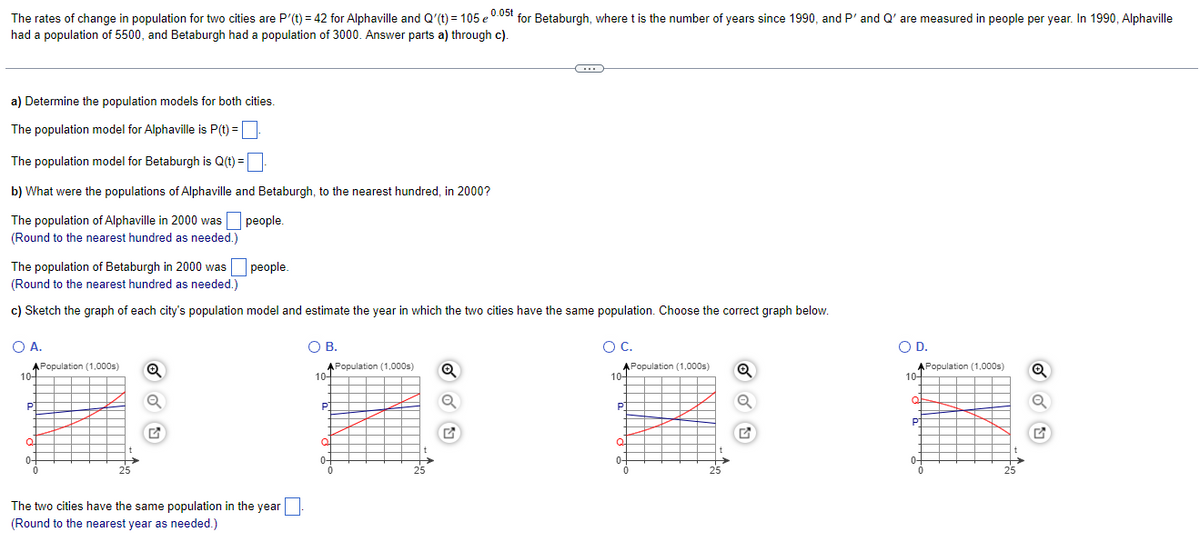The rates of change in population for two cities are P'(t) = 42 for Alphaville and Q'(t) = 105 e 0.05t for Betaburgh, where t is the number of years since 1990, and P' and Q' are measured in people per year. In 1990, Alphaville had a population of 5500, and Betaburgh had a population of 3000. Answer parts a) through c). G a) Determine the population models for both cities. The population model for Alphaville is P(t) = The population model for Betaburgh is Q(t) = b) What were the populations of Alphaville and Betaburgh, to the nearest hundred, in 2000? The population of Alphaville in 2000 was people. (Round to the nearest hundred as needed.) The population of Betaburgh in 2000 was people. (Round to the nearest hundred as needed.) c) Sketch the graph of each city's population model and estimate the year in which the two cities have the same population. Choose the correct graph below. O A. O B. O C. O D. APopulation (1.000s) APopulation (1.000s) Q APopulation (1,000s) Q Q 10- 10- 10- 10- Q Q Q Q P P P G Q Q 0- 0- 0+ The two cities have the same population in the year (Round to the nearest year as needed.) APopulation (1,000s)
The rates of change in population for two cities are P'(t) = 42 for Alphaville and Q'(t) = 105 e 0.05t for Betaburgh, where t is the number of years since 1990, and P' and Q' are measured in people per year. In 1990, Alphaville had a population of 5500, and Betaburgh had a population of 3000. Answer parts a) through c). G a) Determine the population models for both cities. The population model for Alphaville is P(t) = The population model for Betaburgh is Q(t) = b) What were the populations of Alphaville and Betaburgh, to the nearest hundred, in 2000? The population of Alphaville in 2000 was people. (Round to the nearest hundred as needed.) The population of Betaburgh in 2000 was people. (Round to the nearest hundred as needed.) c) Sketch the graph of each city's population model and estimate the year in which the two cities have the same population. Choose the correct graph below. O A. O B. O C. O D. APopulation (1.000s) APopulation (1.000s) Q APopulation (1,000s) Q Q 10- 10- 10- 10- Q Q Q Q P P P G Q Q 0- 0- 0+ The two cities have the same population in the year (Round to the nearest year as needed.) APopulation (1,000s)
Algebra & Trigonometry with Analytic Geometry
13th Edition
ISBN:9781133382119
Author:Swokowski
Publisher:Swokowski
Chapter5: Inverse, Exponential, And Logarithmic Functions
Section: Chapter Questions
Problem 18T
Related questions
Question

Transcribed Image Text:The rates of change in population for two cities are P'(t) = 42 for Alphaville and Q'(t) = 105 e 0.05t for Betaburgh, where t is the number of years since 1990, and P' and Q' are measured in people per year. In 1990, Alphaville
had a population of 5500, and Betaburgh had a population of 3000. Answer parts a) through c).
G
a) Determine the population models for both cities.
The population model for Alphaville is P(t) = .
The population model for Betaburgh is Q(t)=
b) What were the populations of Alphaville and Betaburgh, to the nearest hundred, in 2000?
The population of Alphaville in 2000 was people.
(Round to the nearest hundred as needed.)
people.
The population of Betaburgh in 2000 was
(Round to the nearest hundred as needed.)
c) Sketch the graph of each city's population model and estimate the year in which the two cities have the same population. Choose the correct graph below.
O A.
O B.
O C.
O D.
APopulation (1,000s)
Q
APopulation (1,000s) Q
APopulation (1.000s)
Q
O
10+
10-
10-
10-
Q
Q
Q
P
P
P
G
of
0
Q
0-
0-
0-
The two cities have the same population in the year
(Round to the nearest year as needed.)
APopulation (1.000s)
Expert Solution
This question has been solved!
Explore an expertly crafted, step-by-step solution for a thorough understanding of key concepts.
This is a popular solution!
Trending now
This is a popular solution!
Step by step
Solved in 3 steps with 1 images

Recommended textbooks for you

Algebra & Trigonometry with Analytic Geometry
Algebra
ISBN:
9781133382119
Author:
Swokowski
Publisher:
Cengage

Trigonometry (MindTap Course List)
Trigonometry
ISBN:
9781337278461
Author:
Ron Larson
Publisher:
Cengage Learning


Algebra & Trigonometry with Analytic Geometry
Algebra
ISBN:
9781133382119
Author:
Swokowski
Publisher:
Cengage

Trigonometry (MindTap Course List)
Trigonometry
ISBN:
9781337278461
Author:
Ron Larson
Publisher:
Cengage Learning
